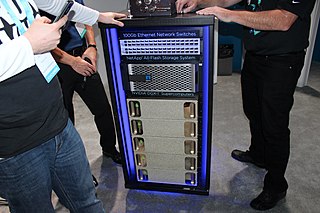Cray Inc., a subsidiary of Hewlett Packard Enterprise, is an American supercomputer manufacturer headquartered in Seattle, Washington. It also manufactures systems for data storage and analytics. Several Cray supercomputer systems are listed in the TOP500, which ranks the most powerful supercomputers in the world.
The transistor count is the number of transistors in an electronic device. It is the most common measure of integrated circuit complexity. The rate at which MOS transistor counts have increased generally follows Moore's law, which observes that transistor count doubles approximately every two years. However, being directly proportional to the area of a chip, transistor count does not represent how advanced the corresponding manufacturing technology is: a better indication of this is transistor density.
The Texas Advanced Computing Center (TACC) at the University of Texas at Austin, United States, is an advanced computing research center that is based on comprehensive advanced computing resources and supports services to researchers in Texas and across the U.S. The mission of TACC is to enable discoveries that advance science and society through the application of advanced computing technologies. Specializing in high performance computing, scientific visualization, data analysis & storage systems, software, research & development and portal interfaces, TACC deploys and operates advanced computational infrastructure to enable the research activities of faculty, staff, and students of UT Austin. TACC also provides consulting, technical documentation, and training to support researchers who use these resources. TACC staff members conduct research and development in applications and algorithms, computing systems design/architecture, and programming tools and environments.

ProLiant is a brand of server computers that was originally developed and marketed by Compaq, Hewlett-Packard (HP), and currently marketed by Hewlett Packard Enterprise (HPE). ProLiant servers were first introduced by Compaq in 1993, succeeding their SystemPro line of servers in the high-end space.

The TOP500 project ranks and details the 500 most powerful non-distributed computer systems in the world. The project was started in 1993 and publishes an updated list of the supercomputers twice a year. The first of these updates always coincides with the International Supercomputing Conference in June, and the second is presented at the ACM/IEEE Supercomputing Conference in November. The project aims to provide a reliable basis for tracking and detecting trends in high-performance computing and bases rankings on HPL benchmarks, a portable implementation of the high-performance LINPACK benchmark written in Fortran for distributed-memory computers.
The Green500 is a biannual ranking of supercomputers, from the TOP500 list of supercomputers, in terms of energy efficiency. The list measures performance per watt using the TOP500 measure of high performance LINPACK benchmarks at double-precision floating-point format.

The Irish Centre for High-End Computing (ICHEC) is the national high-performance computing centre in Ireland. It was established in 2005 and provides supercomputing resources, support, training and related services. ICHEC is involved in education and training, including providing courses for researchers.
The Cray CX1 is a deskside workstation designed by Cray Inc., based on the x86-64 processor architecture. It was launched on September 16, 2008, and was discontinued in early 2012. It comprises a single chassis blade server design that supports a maximum of eight modular single-width blades, giving up to 96 processor cores. Computational load can be run independently on each blade and/or combined using clustering techniques.

Tianhe-I, Tianhe-1, or TH-1 is a supercomputer capable of an Rmax of 2.5 peta FLOPS. Located at the National Supercomputing Center of Tianjin, China, it was the fastest computer in the world from October 2010 to June 2011 and was one of the few petascale supercomputers in the world.

POWER8 is a family of superscalar multi-core microprocessors based on the Power ISA, announced in August 2013 at the Hot Chips conference. The designs are available for licensing under the OpenPOWER Foundation, which is the first time for such availability of IBM's highest-end processors.

Tsubame is a series of supercomputers that operates at the GSIC Center at the Tokyo Institute of Technology in Japan, designed by Satoshi Matsuoka.

ThinkStation is a brand of professional workstations from Lenovo announced in November 2007 and then released in January 2008. They are designed to be used for high-end computing and computer-aided design (CAD) tasks and primarily compete with other enterprise workstation lines, such as Dell's Precision, HP's Z line, Acer's Veriton K series, and Apple's Mac Pro line.

POWER9 is a family of superscalar, multithreading, multi-core microprocessors produced by IBM, based on the Power ISA. It was announced in August 2016. The POWER9-based processors are being manufactured using a 14 nm FinFET process, in 12- and 24-core versions, for scale out and scale up applications, and possibly other variations, since the POWER9 architecture is open for licensing and modification by the OpenPOWER Foundation members.

PICO is an Intel Cluster installed in the data center of Cineca. PICO is intended to enable new "BigData" classes of applications, related to the management and processing of large quantities of data, coming both from simulations and experiments. The cluster is made of an Intel NeXtScale server, designed to optimize density and performance, driving a large data repository shared among all the HPC systems in Cineca.

The Nvidia DGX represents a series of servers and workstations designed by Nvidia, primarily geared towards enhancing deep learning applications through the use of General-Purpose computing on Graphics Processing Units (GPGPU). These systems typically come in a rackmount format featuring high-performance x86 server CPUs on the motherboard.

The OpenBMC project is a Linux Foundation collaborative open-source project that produces an open source implementation of the baseboard management controllers (BMC) firmware stack. OpenBMC is a Linux distribution for BMCs meant to work across heterogeneous systems that include enterprise, high-performance computing (HPC), telecommunications, and cloud-scale data centers.

Intel Xe, earlier known unofficially as Gen12, is a GPU architecture developed by Intel.

Ampere Computing LLC is an American fabless semiconductor company based in Santa Clara, California that develops processors for servers operating in large scale environments. Ampere also has offices in: Portland, Oregon; Taipei, Taiwan; Raleigh, North Carolina; Bangalore, India; Warsaw, Poland; and Ho Chi Minh City, Vietnam.

Leonardo is a petascale supercomputer located at the CINECA datacenter in Bologna, Italy. The system consists of an Atos BullSequana XH2000 computer, with close to 14,000 Nvidia Ampere GPUs and 200 Gbit/s Nvidia Mellanox HDR InfiniBand connectivity. Inaugurated in November 2022, Leonardo is capable of 250 petaflops, making it one of the top five fastest supercomputers in the world. It debuted on the TOP500 in November 2022 ranking fourth in the world, and second in Europe.

Taiwania 3 is one of the supercomputers made by Taiwan, and also the newest one. It is placed in the National Center for High-performance Computing of NARLabs. There are 50,400 cores in total with 900 nodes, using Intel Xeon Platinum 8280 2.4 GHz CPU and using CentOS as Operating System. It is an open access for public supercomputer. It is currently open access to scientists and more to do specific research after getting permission from Taiwan's National Center for High-performance Computing. This is the third supercomputer of the Taiwania series. It uses CentOS x86_64 7.8 as its system operator and Slurm Workload Manager as workflow manager to ensure better performance. Taiwania 3 uses InfiniBand HDR100 100 Gbit/s high speed Internet connection to ensure better performance of the supercomputer. The main memory capability is 192 GB. There's currently two Intel Xeon Platinum 8280 2.4 GHz CPU inside each node. The full calculation capability is 2.7PFLOPS. It is launched into operation in November 2020 before schedule due to the needed for COVID-19. It is currently ranked number 227 on Top 500 list of June, 2021 and number 80 on Green 500 list. It is manufactured by Quanta Computer, Taiwan Fixed Network, and ASUS Cloud.














